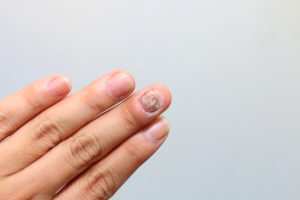
Andrea Bernhard, MD
FAMILY MEDICINE
Dr. Bernhard became a physician in order to make a positive difference in people’s lives. Her goal is to treat every patient with respect and dignity, and to deliver the highest quality care. Dr. Bernhard has lived in Hawaii for 10 years, and even completed her residency at the University of Hawaii. In her own words, “I get to care for wonderful people in one of the most beautiful places in the world.”
Fungal Nail Infections (Tinea Unguium)
Fungal infection causes fingernails or toenails to thicken and unsightly. Sometimes they can even become painful. This condition is common especially among the elderly and affects their toenails.

Fungal nail infection symptoms are below. Extended medication helps cure the infection. People over 60 years of age are more likely to develop this condition. The fingernails are less likely to be affected as compared to toenails. If a toenail is affected, walking becomes difficult. Among younger people, swimmers and athletes are more prone to developing the condition. This is because they share communal showers. This article discusses fungal nail infection symptoms and treatment.
Causes of fungal nail infections
- A fungal infection of the skin, if left untreated, could spread to the nails. For example, athlete’s foot (tinea pedis). This is a skin infection of the toes. If not treated properly, toenails may get affected as well.
- If scratch an infected toenail, it is likely to spread to your fingernails as well as a result.
- Excessive and frequent washing of your hands may damage the protective skin at the base of your nails. Therefore making them more prone to catching an infection.
- Infection is also more likely to occur on a recently damaged fingernail.
- One has an increased risk of developing a fungal nail infection. Such as those suffering from diabetes, psoriasis, poor circulation, weak immune system or general poor health or is a chronic smoker.
- Persons living in humid and hot weather conditions are more prone to get nail infections.
Fungal nail infection symptoms
- Infection of one or more nails.
- Usually painless but can be painful in some cases.
- Nails look discolored and thickened.
- Rarely, white or yellow patches appear under the nail where it can come away from the skin.
- Sometimes the nail may become soft and crumbles or pieces of the nail may fall off, or even the whole nail may come away.
- Inflamed or scaly skin next to the nail.
Tests required
A clipping of your toenail can be sent to a lab to get it tested for fungal infection.
Treatment
In cases where there is little to no pain, the infection is only mild, and fungal nail infection symptoms are mild, not treating it may be an option because:
- There is no guarantee even with treatment. Treatment only cures about 60-80%.
- The appearance of the toenail may not become normal.
- It is a long drawn course of treatment, often lasting months.
You should seek medical help if:
- You have difficulty walking due to an affected nail or symptoms start to bother you.
- Added stress because of abnormal-looking nails.
- Suffer from a condition that puts you at a higher risk for secondary infections. Conditions such as diabetes, a connective tissue disorder or vascular disease.
- If you suspect the infection is spreading to your skin.
- If you have a compromised immune system or are expecting to start treatment for cancer in the coming days.
Medication
Antifungal nail paint (nail lacquer)
Your doctor may prescribe a nail lacquer that contains the antifungal medicine amorolfine. Most fungi that affect nails are treated this way. The nail paint is available in pharmacies with a prescription.
You may need to use it for 6 months to treat fingernails or up to one year for toenails.
Use it exactly as directed for the best results.
Antifungal tablets
- 50% of the cases will go back to looking like normal toenails after treatment.
- The tablets often treat the infections well.
- In 20% of the cases, the treatment will clear the infection but the toenail continues to look discolored.
- Toenails are harder to treat as compared to fingernails.
- If you stop the medication abruptly on your own, the infection may not go away completely.
- If you don’t see a marked improvement in your nails, it could be a case of the wrong diagnosis.
- Other reasons that cause disfiguration of the nails: psoriasis or nail trauma.
Nail removal
A minor surgery after administering local anesthesia to remove the affected nail may be in order if all other treatments have failed to get rid of the infection. Antifungal treatment is usually suggested as well.
Newer treatment techniques
Laser treatment and ultrasound are some of the newer methods of treating fungal nail infections. Research is still on-going but initial results are positive. We will need more data points on the long term effects of these methods.
In ultrasound or laser treatment, the destroyed fungi remain dead on the nail until the nail grows out some more. If the new nail is looking fresh and healthy, the treatment has been successful. Clipping off the affected part of the nail and for the toe to look normal again, may take several months.
Because fingernails are likely to grow faster than toenails, they seem to get better in shorter time periods.
Because the antifungal medication tends to stay in the nail for several months after taking the medication, you may still experience the effects of the medication even after you stop taking it.
What can I do to help?
- Take our medicines exactly as directed by your physician and do not stop taking it abruptly without consulting your doctor.
- If you experience any reaction or side effects to the medication, report it to your doctor, although that is extremely rare.
Tips for prevention
In about 25% of people with a fungal nail infection, it is reported that the infection comes back within three years. Early detection and treatment of athlete’s foot are likely to prevent the infection from spreading to the nail. If you notice itchy or scaly skin between your toes, that is the onset of an athlete’s foot.
- Clip your nails short and smooth out rough edges. If a nail has become thick, use a file to thin it down
- Reserve a pair of nail clippers or scissors to clip infected nails only and do not share it with other persons to avoid spreading of the infection
- Use protective gear such as gloves to prevent injuries to your fingernails. Use fitted shoes that are wide around the toes to prevent toenail infections.
- Ventilate the affected nails and keep them dry as far as possible.
- Avoid injury to nails.
- Avoid walking barefoot in communal toilets, bathrooms or showers.
- Do not share towels with others.
- Replace or discard footwear you used while treating the infection as the footwear may carry some of the fungi spores.
Meet some of our doctors and experts
Here are some of the conditions we treat:
Questions regarding treatment? Contact us! We're here to help.
ALL MAJOR INSURANCE ACCEPTED
Visit with a board-certified Hawaii doctor online or by phone.

Here’s what people are saying
Kaimani
North Shore, Oahu
![]()
"I thought the whole process was pretty cool. To be able do this all on the phone instead of wasting an hour or two to see my doctor and wait all that time to speak with my doctor for only 5 minutes. The best part was I didn't feel rushed either during the video consult. The doctor really took her time speaking with me and more so than my regular doctor would have the time to do so with me.
Susan
Manoa, Oahu
![]()
This was so convenient for me and my family, especially since we are traveling and this saved me a trip to Urgent Care, who knows how long that could have taken. I appreciate how prompt the doctor and the staff were with contacting me.
Meliana
Lahaina, Maui
![]()
This was so great for my Dad to use as he is visiting from another country and he doesnt have health insurance. For something as simple as an earache, we didn't have to spend so much money on a quick doctor's visit. Plus the doctor was able to help my Dad sooner than our scheduled appointment!
Nalu
Mililani, Oahu
![]()
"Everything was very helpful from the initial call down the getting my prescription. I wish I could take this service back home with me to Canada!"
Allie
Lahaina, Maui
![]()
The whole experience was super fast! That was thee fastest appointment I have ever had, especially for something as simple as a prescription refill. Plus I had to pick my son up for school.
Nicki
Kapolei, Oahu
![]()
The fact that I was able to do all of this without getting out of my bed. From the time I made my appointment to hearing my prescription is ready, its been less than 1 hour.
Kawika
Aiea, Oahu
![]()
Video consult was my favorite part. I've never done a telemedicine visit before and it was cool. I can really see this being great for people with busy schedules, not to mention there is nothing like this in Hawaii yet.
Salesi
Lihue, Kauai
![]()
"Convenience from the comfort of your own home. Some times it can be a hassle getting out of house when you're already not feeling well to see your doctor, or even just to get a refill. But this is a very convenient service."
Andrea
Kailua, Oahu
![]()
"Just being able to do it at home and ON TIME was great, because I didn't have to spend the time to commute and spend time in the waiting room to MAYBE see my doctor at my scheduled appointment time. The doctor called me as soon on the dot of my appointment time."
Puka
Waimea, Big Island
![]()
The best part was definitely seeing the doctor on the video call. It is comforting as a patient that there is a real doctor on the other end laying eyes on me and the symptoms I could be having.
Chris
Kona, Big Island
![]()
"The doctor was great and took his time explaining my symptoms and treatment! Actually the whole experience was fantastic! I can't believe how efficient you guys are. It hasn't even been 30 minutes and I've already been contacted by pharmacy that my prescription is ready. This was great. I would definitely use this service again and highly recommend to others!"
We're trusted by local individuals and organizations.









